| Listing 1 - 10 of 15 | << page >> |
Sort by
|
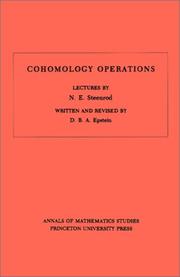
ISBN: 0691079242 1400881676 Year: 2016 Publisher: Princeton, NJ : Princeton University Press,
Abstract | Keywords | Export | Availability | Bookmark
 Loading...
Loading...Choose an application
- Reference Manager
- EndNote
- RefWorks (Direct export to RefWorks)
Written and revised by D. B. A. Epstein.
Category theory. Homological algebra --- 515.14 --- Algebraic topology --- Homology theory. --- 515.14 Algebraic topology --- Cohomology theory --- Contrahomology theory --- Algebra homomorphism. --- Algebra over a field. --- Algebraic structure. --- Approximation. --- Axiom. --- Basis (linear algebra). --- CW complex. --- Cartesian product. --- Classical group. --- Coefficient. --- Cohomology operation. --- Cohomology ring. --- Cohomology. --- Commutative property. --- Complex number. --- Computation. --- Continuous function. --- Cup product. --- Cyclic group. --- Diagram (category theory). --- Dimension. --- Direct limit. --- Embedding. --- Existence theorem. --- Fibration. --- Homomorphism. --- Hopf algebra. --- Hopf invariant. --- Ideal (ring theory). --- Integer. --- Inverse limit. --- Manifold. --- Mathematics. --- Monomial. --- N-skeleton. --- Natural transformation. --- Permutation. --- Quaternion. --- Ring (mathematics). --- Scalar (physics). --- Special unitary group. --- Steenrod algebra. --- Stiefel manifold. --- Subgroup. --- Subset. --- Summation. --- Symmetric group. --- Symplectic group. --- Theorem. --- Uniqueness theorem. --- Upper and lower bounds. --- Vector field. --- Vector space. --- W0.
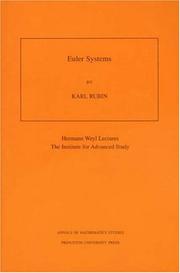
ISBN: 0691050759 1400865204 9781400865208 0691050767 9780691050768 9780691050751 9780691050768 Year: 2000 Publisher: Princeton : Princeton University Press,
Abstract | Keywords | Export | Availability | Bookmark
 Loading...
Loading...Choose an application
- Reference Manager
- EndNote
- RefWorks (Direct export to RefWorks)
One of the most exciting new subjects in Algebraic Number Theory and Arithmetic Algebraic Geometry is the theory of Euler systems. Euler systems are special collections of cohomology classes attached to p-adic Galois representations. Introduced by Victor Kolyvagin in the late 1980's in order to bound Selmer groups attached to p-adic representations, Euler systems have since been used to solve several key problems. These include certain cases of the Birch and Swinnerton-Dyer Conjecture and the Main Conjecture of Iwasawa Theory. Because Selmer groups play a central role in Arithmetic Algebraic Geometry, Euler systems should be a powerful tool in the future development of the field. Here, in the first book to appear on the subject, Karl Rubin presents a self-contained development of the theory of Euler systems. Rubin first reviews and develops the necessary facts from Galois cohomology. He then introduces Euler systems, states the main theorems, and develops examples and applications. The remainder of the book is devoted to the proofs of the main theorems as well as some further speculations. The book assumes a solid background in algebraic Number Theory, and is suitable as an advanced graduate text. As a research monograph it will also prove useful to number theorists and researchers in Arithmetic Algebraic Geometry.
Algebraic number theory. --- p-adic numbers. --- Numbers, p-adic --- Number theory --- p-adic analysis --- Galois cohomology --- Cohomologie galoisienne. --- Algebraic number theory --- p-adic numbers --- Abelian extension. --- Abelian variety. --- Absolute Galois group. --- Algebraic closure. --- Barry Mazur. --- Big O notation. --- Birch and Swinnerton-Dyer conjecture. --- Cardinality. --- Class field theory. --- Coefficient. --- Cohomology. --- Complex multiplication. --- Conjecture. --- Corollary. --- Cyclotomic field. --- Dimension (vector space). --- Divisibility rule. --- Eigenvalues and eigenvectors. --- Elliptic curve. --- Error term. --- Euler product. --- Euler system. --- Exact sequence. --- Existential quantification. --- Field of fractions. --- Finite set. --- Functional equation. --- Galois cohomology. --- Galois group. --- Galois module. --- Gauss sum. --- Global field. --- Heegner point. --- Ideal class group. --- Integer. --- Inverse limit. --- Inverse system. --- Karl Rubin. --- Local field. --- Mathematical induction. --- Maximal ideal. --- Modular curve. --- Modular elliptic curve. --- Natural number. --- Orthogonality. --- P-adic number. --- Pairing. --- Principal ideal. --- R-factor (crystallography). --- Ralph Greenberg. --- Remainder. --- Residue field. --- Ring of integers. --- Scientific notation. --- Selmer group. --- Subgroup. --- Tate module. --- Taylor series. --- Tensor product. --- Theorem. --- Upper and lower bounds. --- Victor Kolyvagin. --- Courbes elliptiques --- Nombres, Théorie des
Book
ISBN: 1400881234 Year: 2016 Publisher: Princeton, New Jersey : Princeton University Press,
Abstract | Keywords | Export | Availability | Bookmark
 Loading...
Loading...Choose an application
- Reference Manager
- EndNote
- RefWorks (Direct export to RefWorks)
The p-adic Simpson correspondence, recently initiated by Gerd Faltings, aims at describing all p-adic representations of the fundamental group of a proper smooth variety over a p-adic field in terms of linear algebra-namely Higgs bundles. This book undertakes a systematic development of the theory following two new approaches, one by Ahmed Abbes and Michel Gros, the other by Takeshi Tsuji. The authors mainly focus on generalized representations of the fundamental group that are p-adically close to the trivial representation.The first approach relies on a new family of period rings built from the torsor of deformations of the variety over a universal p-adic thickening defined by J. M. Fontaine. The second approach introduces a crystalline-type topos and replaces the notion of Higgs bundles with that of Higgs isocrystals. The authors show the compatibility of the two constructions and the compatibility of the correspondence with the natural cohomologies. The last part of the volume contains results of wider interest in p-adic Hodge theory. The reader will find a concise introduction to Faltings' theory of almost étale extensions and a chapter devoted to the Faltings topos. Though this topos is the general framework for Faltings' approach in p-adic Hodge theory, it remains relatively unexplored. The authors present a new approach based on a generalization of P. Deligne's covanishing topos.
Group theory. --- p-adic groups. --- Geometry, Algebraic. --- Algebraic geometry --- Geometry --- Groups, p-adic --- Group theory --- Groups, Theory of --- Substitutions (Mathematics) --- Algebra --- Dolbeault generalized representation. --- Dolbeault module. --- Dolbeault representation. --- Faltings cohomology. --- Faltings extension. --- Faltings ringed topos. --- Faltings site. --- Faltings topos. --- Galois cohomology. --- Gerd Faltings. --- Higgs bundle. --- Higgs bundles. --- Higgs crystals. --- Higgs envelopes. --- Higgs isocrystal. --- HiggsДate algebra. --- HodgeДate representation. --- HodgeДate structure. --- HodgeДate theory. --- Hyodo's theory. --- Koszul complex. --- additive categories. --- adic module. --- almost faithfully flat descent. --- almost faithfully flat module. --- almost flat module. --- almost isomorphism. --- almost tale covering. --- almost tale extension. --- cohomology. --- covanishing topos. --- crystalline-type topos. --- deformation. --- discrete AЇ-module. --- finite tale site. --- fundamental group. --- generalized covanishing topos. --- generalized representation. --- inverse limit. --- linear algebra. --- locally irreducible scheme. --- morphism. --- overconvergence. --- p-adic Hodge theory. --- p-adic Simpson correspondence. --- p-adic field. --- period ring. --- ringed covanishing topos. --- ringed total topos. --- small generalized representation. --- small representation. --- solvable Higgs module. --- tale cohomology. --- tale fundamental group. --- torsor.
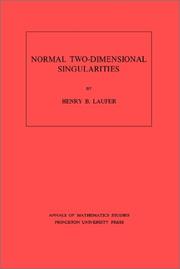
ISBN: 069108100X 1400881749 9780691081007 Year: 1971 Volume: 71 Publisher: Princeton : Princeton University Press,
Abstract | Keywords | Export | Availability | Bookmark
 Loading...
Loading...Choose an application
- Reference Manager
- EndNote
- RefWorks (Direct export to RefWorks)
A survey, thorough and timely, of the singularities of two-dimensional normal complex analytic varieties, the volume summarizes the results obtained since Hirzebruch's thesis (1953) and presents new contributions. First, the singularity is resolved and shown to be classified by its resolution; then, resolutions are classed by the use of spaces with nilpotents; finally, the spaces with nilpotents are determined by means of the local ring structure of the singularity.
Algebraic geometry --- Analytic spaces --- SINGULARITIES (Mathematics) --- 512.76 --- Singularities (Mathematics) --- Geometry, Algebraic --- Spaces, Analytic --- Analytic functions --- Functions of several complex variables --- Birational geometry. Mappings etc. --- Analytic spaces. --- Singularities (Mathematics). --- 512.76 Birational geometry. Mappings etc. --- Birational geometry. Mappings etc --- Analytic function. --- Analytic set. --- Analytic space. --- Automorphism. --- Bernhard Riemann. --- Big O notation. --- Calculation. --- Chern class. --- Codimension. --- Coefficient. --- Cohomology. --- Compact Riemann surface. --- Complex manifold. --- Computation. --- Connected component (graph theory). --- Continuous function. --- Contradiction. --- Coordinate system. --- Corollary. --- Covering space. --- Dimension. --- Disjoint union. --- Divisor. --- Dual graph. --- Elliptic curve. --- Elliptic function. --- Embedding. --- Existential quantification. --- Factorization. --- Fiber bundle. --- Finite set. --- Formal power series. --- Hausdorff space. --- Holomorphic function. --- Homeomorphism. --- Homology (mathematics). --- Intersection (set theory). --- Intersection number (graph theory). --- Inverse limit. --- Irreducible component. --- Isolated singularity. --- Iteration. --- Lattice (group). --- Line bundle. --- Linear combination. --- Line–line intersection. --- Local coordinates. --- Local ring. --- Mathematical induction. --- Maximal ideal. --- Meromorphic function. --- Monic polynomial. --- Nilpotent. --- Normal bundle. --- Open set. --- Parameter. --- Plane curve. --- Pole (complex analysis). --- Power series. --- Presheaf (category theory). --- Projective line. --- Quadratic transformation. --- Quantity. --- Riemann surface. --- Riemann–Roch theorem. --- Several complex variables. --- Submanifold. --- Subset. --- Tangent bundle. --- Tangent space. --- Tensor algebra. --- Theorem. --- Topological space. --- Transition function. --- Two-dimensional space. --- Variable (mathematics). --- Zero divisor. --- Zero of a function. --- Zero set. --- Variétés complexes --- Espaces analytiques
Book
ISBN: 9780691140490 9780691140483 0691140480 0691140499 9786612644955 1400830559 1282644955 9781400830558 9781282644953 6612644958 Year: 2009 Volume: 170 Publisher: Princeton, NJ
Abstract | Keywords | Export | Availability | Bookmark
 Loading...
Loading...Choose an application
- Reference Manager
- EndNote
- RefWorks (Direct export to RefWorks)
Higher category theory is generally regarded as technical and forbidding, but part of it is considerably more tractable: the theory of infinity-categories, higher categories in which all higher morphisms are assumed to be invertible. In Higher Topos Theory, Jacob Lurie presents the foundations of this theory, using the language of weak Kan complexes introduced by Boardman and Vogt, and shows how existing theorems in algebraic topology can be reformulated and generalized in the theory's new language. The result is a powerful theory with applications in many areas of mathematics. The book's first five chapters give an exposition of the theory of infinity-categories that emphasizes their role as a generalization of ordinary categories. Many of the fundamental ideas from classical category theory are generalized to the infinity-categorical setting, such as limits and colimits, adjoint functors, ind-objects and pro-objects, locally accessible and presentable categories, Grothendieck fibrations, presheaves, and Yoneda's lemma. A sixth chapter presents an infinity-categorical version of the theory of Grothendieck topoi, introducing the notion of an infinity-topos, an infinity-category that resembles the infinity-category of topological spaces in the sense that it satisfies certain axioms that codify some of the basic principles of algebraic topology. A seventh and final chapter presents applications that illustrate connections between the theory of higher topoi and ideas from classical topology.
Algebraic geometry --- Topology --- Toposes --- Categories (Mathematics) --- Categories (Mathematics). --- Toposes. --- Algebra --- Mathematics --- Physical Sciences & Mathematics --- Category theory (Mathematics) --- Topoi (Mathematics) --- Algebra, Homological --- Algebra, Universal --- Group theory --- Logic, Symbolic and mathematical --- Functor theory --- Adjoint functors. --- Associative property. --- Base change map. --- Base change. --- CW complex. --- Canonical map. --- Cartesian product. --- Category of sets. --- Category theory. --- Coequalizer. --- Cofinality. --- Coherence theorem. --- Cohomology. --- Cokernel. --- Commutative property. --- Continuous function (set theory). --- Contractible space. --- Coproduct. --- Corollary. --- Derived category. --- Diagonal functor. --- Diagram (category theory). --- Dimension theory (algebra). --- Dimension theory. --- Dimension. --- Enriched category. --- Epimorphism. --- Equivalence class. --- Equivalence relation. --- Existence theorem. --- Existential quantification. --- Factorization system. --- Functor category. --- Functor. --- Fundamental group. --- Grothendieck topology. --- Grothendieck universe. --- Group homomorphism. --- Groupoid. --- Heyting algebra. --- Higher Topos Theory. --- Higher category theory. --- Homotopy category. --- Homotopy colimit. --- Homotopy group. --- Homotopy. --- I0. --- Inclusion map. --- Inductive dimension. --- Initial and terminal objects. --- Inverse limit. --- Isomorphism class. --- Kan extension. --- Limit (category theory). --- Localization of a category. --- Maximal element. --- Metric space. --- Model category. --- Monoidal category. --- Monoidal functor. --- Monomorphism. --- Monotonic function. --- Morphism. --- Natural transformation. --- Nisnevich topology. --- Noetherian topological space. --- Noetherian. --- O-minimal theory. --- Open set. --- Power series. --- Presheaf (category theory). --- Prime number. --- Pullback (category theory). --- Pushout (category theory). --- Quillen adjunction. --- Quotient by an equivalence relation. --- Regular cardinal. --- Retract. --- Right inverse. --- Sheaf (mathematics). --- Sheaf cohomology. --- Simplicial category. --- Simplicial set. --- Special case. --- Subcategory. --- Subset. --- Surjective function. --- Tensor product. --- Theorem. --- Topological space. --- Topology. --- Topos. --- Total order. --- Transitive relation. --- Universal property. --- Upper and lower bounds. --- Weak equivalence (homotopy theory). --- Yoneda lemma. --- Zariski topology. --- Zorn's lemma.
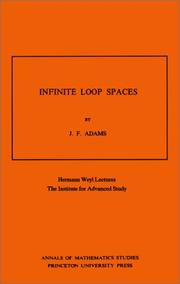
ISBN: 0691082073 0691082065 1400821258 Year: 1978 Volume: no. 90 Publisher: Princeton : Tokyo : Princeton University Press University of Tokyo press,
Abstract | Keywords | Export | Availability | Bookmark
 Loading...
Loading...Choose an application
- Reference Manager
- EndNote
- RefWorks (Direct export to RefWorks)
The theory of infinite loop spaces has been the center of much recent activity in algebraic topology. Frank Adams surveys this extensive work for researchers and students. Among the major topics covered are generalized cohomology theories and spectra; infinite-loop space machines in the sense of Boadman-Vogt, May, and Segal; localization and group completion; the transfer; the Adams conjecture and several proofs of it; and the recent theories of Adams and Priddy and of Madsen, Snaith, and Tornehave.
Algebraic topology --- Loop spaces --- Espaces de lacets --- Infinite loop spaces. --- Abelian group. --- Adams spectral sequence. --- Adjoint functors. --- Algebraic K-theory. --- Algebraic topology. --- Automorphism. --- Axiom. --- Bott periodicity theorem. --- CW complex. --- Calculation. --- Cartesian product. --- Cobordism. --- Coefficient. --- Cofibration. --- Cohomology operation. --- Cohomology ring. --- Cohomology. --- Commutative diagram. --- Continuous function. --- Counterexample. --- De Rham cohomology. --- Diagram (category theory). --- Differentiable manifold. --- Dimension. --- Discrete space. --- Disjoint union. --- Double coset. --- Eilenberg. --- Eilenberg–Steenrod axioms. --- Endomorphism. --- Epimorphism. --- Equivalence class. --- Euler class. --- Existential quantification. --- Explicit formulae (L-function). --- Exterior algebra. --- F-space. --- Fiber bundle. --- Fibration. --- Finite group. --- Function composition. --- Function space. --- Functor. --- Fundamental class. --- Fundamental group. --- Geometry. --- H-space. --- Homology (mathematics). --- Homomorphism. --- Homotopy category. --- Homotopy group. --- Homotopy. --- Hurewicz theorem. --- Inverse limit. --- J-homomorphism. --- K-theory. --- Limit (mathematics). --- Loop space. --- Mathematical induction. --- Maximal torus. --- Module (mathematics). --- Monoid. --- Monoidal category. --- Moore space. --- Morphism. --- Multiplication. --- Natural transformation. --- P-adic number. --- P-complete. --- Parameter space. --- Permutation. --- Prime number. --- Principal bundle. --- Principal ideal domain. --- Pullback (category theory). --- Quotient space (topology). --- Reduced homology. --- Riemannian manifold. --- Ring spectrum. --- Serre spectral sequence. --- Simplicial set. --- Simplicial space. --- Special case. --- Spectral sequence. --- Stable homotopy theory. --- Steenrod algebra. --- Subalgebra. --- Subring. --- Subset. --- Surjective function. --- Theorem. --- Theory. --- Topological K-theory. --- Topological ring. --- Topological space. --- Topology. --- Universal bundle. --- Universal coefficient theorem. --- Vector bundle. --- Weak equivalence (homotopy theory). --- Topologie algébrique
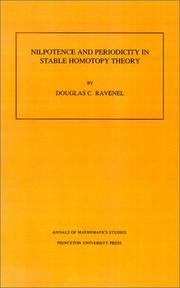
ISBN: 069108792X 069102572X 1400882486 9780691025728 9780691087924 Year: 2016 Volume: 128 Publisher: Princeton, NJ : Princeton University Press,
Abstract | Keywords | Export | Availability | Bookmark
 Loading...
Loading...Choose an application
- Reference Manager
- EndNote
- RefWorks (Direct export to RefWorks)
Nilpotence and Periodicity in Stable Homotopy Theory describes some major advances made in algebraic topology in recent years, centering on the nilpotence and periodicity theorems, which were conjectured by the author in 1977 and proved by Devinatz, Hopkins, and Smith in 1985. During the last ten years a number of significant advances have been made in homotopy theory, and this book fills a real need for an up-to-date text on that topic. Ravenel's first few chapters are written with a general mathematical audience in mind. They survey both the ideas that lead up to the theorems and their applications to homotopy theory. The book begins with some elementary concepts of homotopy theory that are needed to state the problem. This includes such notions as homotopy, homotopy equivalence, CW-complex, and suspension. Next the machinery of complex cobordism, Morava K-theory, and formal group laws in characteristic p are introduced. The latter portion of the book provides specialists with a coherent and rigorous account of the proofs. It includes hitherto unpublished material on the smash product and chromatic convergence theorems and on modular representations of the symmetric group.
Homotopie --- Homotopy theory --- Homotopy theory. --- Deformations, Continuous --- Topology --- Abelian category. --- Abelian group. --- Adams spectral sequence. --- Additive category. --- Affine space. --- Algebra homomorphism. --- Algebraic closure. --- Algebraic structure. --- Algebraic topology (object). --- Algebraic topology. --- Algebraic variety. --- Algebraically closed field. --- Atiyah–Hirzebruch spectral sequence. --- Automorphism. --- Boolean algebra (structure). --- CW complex. --- Canonical map. --- Cantor set. --- Category of topological spaces. --- Category theory. --- Classification theorem. --- Classifying space. --- Cohomology operation. --- Cohomology. --- Cokernel. --- Commutative algebra. --- Commutative ring. --- Complex projective space. --- Complex vector bundle. --- Computation. --- Conjecture. --- Conjugacy class. --- Continuous function. --- Contractible space. --- Coproduct. --- Differentiable manifold. --- Disjoint union. --- Division algebra. --- Equation. --- Explicit formulae (L-function). --- Functor. --- G-module. --- Groupoid. --- Homology (mathematics). --- Homomorphism. --- Homotopy category. --- Homotopy group. --- Homotopy. --- Hopf algebra. --- Hurewicz theorem. --- Inclusion map. --- Infinite product. --- Integer. --- Inverse limit. --- Irreducible representation. --- Isomorphism class. --- K-theory. --- Loop space. --- Mapping cone (homological algebra). --- Mathematical induction. --- Modular representation theory. --- Module (mathematics). --- Monomorphism. --- Moore space. --- Morava K-theory. --- Morphism. --- N-sphere. --- Noetherian ring. --- Noetherian. --- Noncommutative ring. --- Number theory. --- P-adic number. --- Piecewise linear manifold. --- Polynomial ring. --- Polynomial. --- Power series. --- Prime number. --- Principal ideal domain. --- Profinite group. --- Reduced homology. --- Ring (mathematics). --- Ring homomorphism. --- Ring spectrum. --- Simplicial complex. --- Simply connected space. --- Smash product. --- Special case. --- Spectral sequence. --- Steenrod algebra. --- Sub"ient. --- Subalgebra. --- Subcategory. --- Subring. --- Symmetric group. --- Tensor product. --- Theorem. --- Topological space. --- Topology. --- Vector bundle. --- Zariski topology.
Book
ISBN: 0691082189 1322886407 0691628084 0691648328 1400867312 Year: 1978 Publisher: Princeton : Tokyo : Princeton University Press ; University of Tokyo press,
Abstract | Keywords | Export | Availability | Bookmark
 Loading...
Loading...Choose an application
- Reference Manager
- EndNote
- RefWorks (Direct export to RefWorks)
Written by Arthur Ogus on the basis of notes from Pierre Berthelot's seminar on crystalline cohomology at Princeton University in the spring of 1974, this book constitutes an informal introduction to a significant branch of algebraic geometry. Specifically, it provides the basic tools used in the study of crystalline cohomology of algebraic varieties in positive characteristic.Originally published in 1978.The Princeton Legacy Library uses the latest print-on-demand technology to again make available previously out-of-print books from the distinguished backlist of Princeton University Press. These editions preserve the original texts of these important books while presenting them in durable paperback and hardcover editions. The goal of the Princeton Legacy Library is to vastly increase access to the rich scholarly heritage found in the thousands of books published by Princeton University Press since its founding in 1905.
Algebraic geometry --- Geometry, Algebraic. --- Homology theory. --- Functions, Zeta. --- Zeta functions --- Cohomology theory --- Contrahomology theory --- Algebraic topology --- Geometry --- Abelian category. --- Additive map. --- Adjoint functors. --- Adjunction (field theory). --- Adjunction formula. --- Alexander Grothendieck. --- Algebra homomorphism. --- Artinian. --- Automorphism. --- Axiom. --- Banach space. --- Base change map. --- Base change. --- Betti number. --- Calculation. --- Cartesian product. --- Category of abelian groups. --- Characteristic polynomial. --- Characterization (mathematics). --- Closed immersion. --- Codimension. --- Coefficient. --- Cohomology. --- Cokernel. --- Commutative diagram. --- Commutative property. --- Commutative ring. --- Compact space. --- Corollary. --- Crystalline cohomology. --- De Rham cohomology. --- Degeneracy (mathematics). --- Derived category. --- Diagram (category theory). --- Differential operator. --- Discrete valuation ring. --- Divisibility rule. --- Dual basis. --- Eigenvalues and eigenvectors. --- Endomorphism. --- Epimorphism. --- Equation. --- Equivalence of categories. --- Exact sequence. --- Existential quantification. --- Explicit formula. --- Explicit formulae (L-function). --- Exponential type. --- Exterior algebra. --- Exterior derivative. --- Formal power series. --- Formal scheme. --- Frobenius endomorphism. --- Functor. --- Fundamental theorem. --- Hasse invariant. --- Hodge theory. --- Homotopy. --- Ideal (ring theory). --- Initial and terminal objects. --- Inverse image functor. --- Inverse limit. --- Inverse system. --- K-theory. --- Leray spectral sequence. --- Linear map. --- Linearization. --- Locally constant function. --- Mapping cone (homological algebra). --- Mathematical induction. --- Maximal ideal. --- Module (mathematics). --- Monomial. --- Monotonic function. --- Morphism. --- Natural transformation. --- Newton polygon. --- Noetherian ring. --- Noetherian. --- P-adic number. --- Polynomial. --- Power series. --- Presheaf (category theory). --- Projective module. --- Scientific notation. --- Series (mathematics). --- Sheaf (mathematics). --- Sheaf of modules. --- Special case. --- Spectral sequence. --- Subring. --- Subset. --- Symmetric algebra. --- Theorem. --- Topological space. --- Topology. --- Topos. --- Transitive relation. --- Universal property. --- Zariski topology. --- Geometrie algebrique --- Topologie algebrique --- Varietes algebriques --- Cohomologie
Book
ISBN: 1282458582 9786612458583 1400831970 9781400831975 0691142483 9780691142487 0691142491 9780691142494 9781282458581 6612458585 Year: 2009 Publisher: Princeton, NJ
Abstract | Keywords | Export | Availability | Bookmark
 Loading...
Loading...Choose an application
- Reference Manager
- EndNote
- RefWorks (Direct export to RefWorks)
Outer billiards is a basic dynamical system defined relative to a convex shape in the plane. B. H. Neumann introduced this system in the 1950's, and J. Moser popularized it as a toy model for celestial mechanics. All along, the so-called Moser-Neumann question has been one of the central problems in the field. This question asks whether or not one can have an outer billiards system with an unbounded orbit. The Moser-Neumann question is an idealized version of the question of whether, because of small disturbances in its orbit, the Earth can break out of its orbit and fly away from the Sun. In Outer Billiards on Kites, Richard Schwartz presents his affirmative solution to the Moser-Neumann problem. He shows that an outer billiards system can have an unbounded orbit when defined relative to any irrational kite. A kite is a quadrilateral having a diagonal that is a line of bilateral symmetry. The kite is irrational if the other diagonal divides the quadrilateral into two triangles whose areas are not rationally related. In addition to solving the basic problem, Schwartz relates outer billiards on kites to such topics as Diophantine approximation, the modular group, self-similar sets, polytope exchange maps, profinite completions of the integers, and solenoids--connections that together allow for a fairly complete analysis of the dynamical system.
Hyperbolic spaces. --- Singularities (Mathematics) --- Transformations (Mathematics) --- Geometry, Plane. --- Plane geometry --- Algorithms --- Differential invariants --- Geometry, Differential --- Geometry, Algebraic --- Hyperbolic complex manifolds --- Manifolds, Hyperbolic complex --- Spaces, Hyperbolic --- Geometry, Non-Euclidean --- Abelian group. --- Automorphism. --- Big O notation. --- Bijection. --- Binary number. --- Bisection. --- Borel set. --- C0. --- Calculation. --- Cantor set. --- Cartesian coordinate system. --- Combination. --- Compass-and-straightedge construction. --- Congruence subgroup. --- Conjecture. --- Conjugacy class. --- Continuity equation. --- Convex lattice polytope. --- Convex polytope. --- Coprime integers. --- Counterexample. --- Cyclic group. --- Diameter. --- Diophantine approximation. --- Diophantine equation. --- Disjoint sets. --- Disjoint union. --- Division by zero. --- Embedding. --- Equation. --- Equivalence class. --- Ergodic theory. --- Ergodicity. --- Factorial. --- Fiber bundle. --- Fibonacci number. --- Fundamental domain. --- Gauss map. --- Geometry. --- Half-integer. --- Homeomorphism. --- Hyperbolic geometry. --- Hyperplane. --- Ideal triangle. --- Intersection (set theory). --- Interval exchange transformation. --- Inverse function. --- Inverse limit. --- Isometry group. --- Lattice (group). --- Limit set. --- Line segment. --- Linear algebra. --- Linear function. --- Line–line intersection. --- Main diagonal. --- Modular group. --- Monotonic function. --- Multiple (mathematics). --- Orthant. --- Outer billiard. --- Parallelogram. --- Parameter. --- Partial derivative. --- Penrose tiling. --- Permutation. --- Piecewise. --- Polygon. --- Polyhedron. --- Polytope. --- Product topology. --- Projective geometry. --- Rectangle. --- Renormalization. --- Rhombus. --- Right angle. --- Rotational symmetry. --- Sanity check. --- Scientific notation. --- Semicircle. --- Sign (mathematics). --- Special case. --- Square root of 2. --- Subsequence. --- Summation. --- Symbolic dynamics. --- Symmetry group. --- Tangent. --- Tetrahedron. --- Theorem. --- Toy model. --- Translational symmetry. --- Trapezoid. --- Triangle group. --- Triangle inequality. --- Two-dimensional space. --- Upper and lower bounds. --- Upper half-plane. --- Without loss of generality. --- Yair Minsky.
Book
ISBN: 1400881226 9781400881222 9780691161693 9780691161686 0691161682 9780691161686 0691161690 9780691161693 Year: 2016 Publisher: Princeton, NJ
Abstract | Keywords | Export | Availability | Bookmark
 Loading...
Loading...Choose an application
- Reference Manager
- EndNote
- RefWorks (Direct export to RefWorks)
Over the field of real numbers, analytic geometry has long been in deep interaction with algebraic geometry, bringing the latter subject many of its topological insights. In recent decades, model theory has joined this work through the theory of o-minimality, providing finiteness and uniformity statements and new structural tools. For non-archimedean fields, such as the p-adics, the Berkovich analytification provides a connected topology with many thoroughgoing analogies to the real topology on the set of complex points, and it has become an important tool in algebraic dynamics and many other areas of geometry. This book lays down model-theoretic foundations for non-archimedean geometry. The methods combine o-minimality and stability theory. Definable types play a central role, serving first to define the notion of a point and then properties such as definable compactness. Beyond the foundations, the main theorem constructs a deformation retraction from the full non-archimedean space of an algebraic variety to a rational polytope. This generalizes previous results of V. Berkovich, who used resolution of singularities methods. No previous knowledge of non-archimedean geometry is assumed. Model-theoretic prerequisites are reviewed in the first sections.
Tame algebras. --- Algebras, Tame --- Associative algebras --- Abhyankar property. --- Berkovich space. --- Galois orbit. --- Riemann-Roch. --- Zariski dense open set. --- Zariski open subset. --- Zariski topology. --- algebraic geometry. --- algebraic variety. --- algebraically closed valued field. --- analytic geometry. --- birational invariant. --- canonical extension. --- connectedness. --- continuity criteria. --- continuous definable map. --- continuous map. --- curve fibration. --- definable compactness. --- definable function. --- definable homotopy type. --- definable set. --- definable space. --- definable subset. --- definable topological space. --- definable topology. --- definable type. --- definably compact set. --- deformation retraction. --- finite simplicial complex. --- finite-dimensional vector space. --- forward-branching point. --- fundamental space. --- g-continuity. --- g-continuous. --- g-open set. --- germ. --- good metric. --- homotopy equivalence. --- homotopy. --- imaginary base set. --- ind-definable set. --- ind-definable subset. --- inflation homotopy. --- inflation. --- inverse limit. --- iso-definability. --- iso-definable set. --- iso-definable subset. --- iterated place. --- linear topology. --- main theorem. --- model theory. --- morphism. --- natural functor. --- non-archimedean geometry. --- non-archimedean tame topology. --- o-minimal formulation. --- o-minimality. --- orthogonality. --- path. --- pro-definable bijection. --- pro-definable map. --- pro-definable set. --- pro-definable subset. --- pseudo-Galois covering. --- real numbers. --- relatively compact set. --- residue field extension. --- retraction. --- schematic distance. --- semi-lattice. --- sequence. --- smooth case. --- smoothness. --- stability theory. --- stable completion. --- stable domination. --- stably dominated point. --- stably dominated type. --- stably dominated. --- strong stability. --- substructure. --- topological embedding. --- topological space. --- topological structure. --- topology. --- transcendence degree. --- v-continuity. --- valued field. --- Γ-internal set. --- Γ-internal space. --- Γ-internal subset.
| Listing 1 - 10 of 15 | << page >> |
Sort by
|

 Search
Search Feedback
Feedback About UniCat
About UniCat  Help
Help News
News